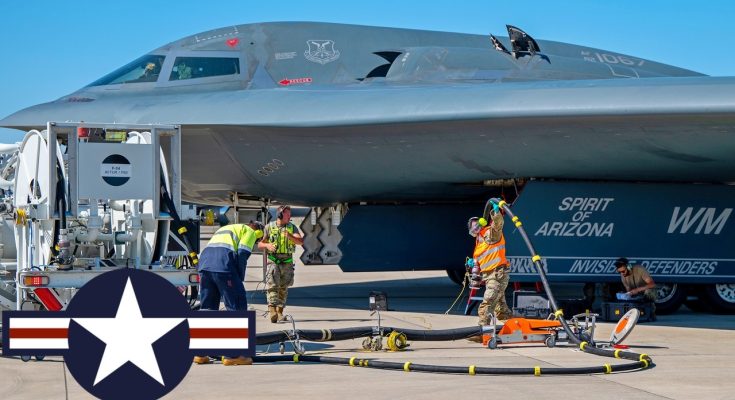USAF: Powerful B-2 Spirit Stealth Bombers During Military Exercises in Australia
The deployment of B-2 Spirit stealth bombers to Australia for military exercises underscores the strengthening of U.S. military ties with its allies in the Pacific region, as well as the U.S. Air Force’s commitment to maintaining a strategic presence in the Indo-Pacific. The B-2 Spirit, known for its cutting-edge stealth capabilities, long-range strike power, and versatility, is a cornerstone of America’s global power projection and deterrence strategy. By involving these advanced bombers in exercises in Australia, the United States not only demonstrates its military might but also bolsters the operational readiness of allied forces in a region that is increasingly viewed as vital to global security.
The Role of the B-2 Spirit
The B-2 Spirit, developed by Northrop Grumman, is a fifth-generation stealth bomber designed for penetrating sophisticated enemy air defenses and delivering both conventional and nuclear payloads. Its unique flying-wing design, combined with advanced stealth technology, allows it to evade radar detection, making it one of the most feared aircraft in the world. The B-2 is capable of carrying a wide range of munitions, including precision-guided bombs and nuclear weapons, and can perform deep strike missions over vast distances without the need for refueling.
The aircraft’s capabilities make it ideal for long-range, high-precision missions. This strategic bomber’s ability to fly at altitudes that make it difficult for adversaries to target, coupled with its ability to strike with unparalleled accuracy, makes it a key component of the U.S. military’s global reach and deterrence capabilities.
B-2 Deployment in Australia: Strategic Implications
In recent years, the U.S. has increasingly focused on enhancing its military presence in the Indo-Pacific, with Australia being a critical partner in this strategy. The B-2’s participation in joint military exercises in Australia, such as Exercise Pitch Black, demonstrates the importance of interoperability between the U.S. and Australian forces. These exercises are designed to enhance collaboration, hone operational tactics, and ensure that both nations are ready to respond to potential threats in the region.
The Indo-Pacific is a region of significant strategic interest due to rising tensions, particularly with China’s growing military presence and assertiveness in the South China Sea. The U.S. and Australia, both key players in the region, share mutual interests in maintaining stability, securing maritime routes, and countering any form of aggression. By deploying B-2 bombers to Australia, the U.S. signals its commitment to these objectives and reinforces its ability to project power across the Indo-Pacific.
Training and Interoperability
The B-2’s involvement in military exercises in Australia provides invaluable training for both U.S. Air Force crews and their Australian counterparts. While the B-2 is a unique asset with distinct capabilities, its deployment alongside Australian fighter jets and other military assets enhances the overall interoperability of both forces. The exercises typically focus on coordinated operations in multi-domain environments, which include air, land, and sea forces working together seamlessly to respond to a variety of scenarios.
The B-2’s participation also provides the opportunity for both U.S. and Australian forces to test their ability to conduct joint operations involving long-range strike missions, air-to-air refueling, and integrated defense strategies. The inclusion of the B-2 in these exercises is a testament to its critical role in modern warfare, particularly in scenarios where rapid deployment and deep penetration into enemy territory are required.
Strategic Deterrence and Regional Stability
The presence of B-2 bombers in the region also serves as a powerful symbol of deterrence. The stealth bomber’s ability to deliver precision strikes over long distances, including potential nuclear strikes, reinforces the U.S.’s strategic posture in the Indo-Pacific. It sends a clear message to adversaries in the region that the U.S. has the capability to strike swiftly and decisively, should the need arise.
Moreover, the B-2’s advanced stealth features allow it to operate in contested environments where traditional aircraft may be vulnerable. In an era where adversaries are developing sophisticated air defense systems, having the B-2 as a force multiplier ensures that the U.S. maintains its edge in strategic bombing capabilities.
Conclusion
The deployment of the B-2 Spirit stealth bombers during military exercises in Australia is a reflection of the evolving security dynamics in the Indo-Pacific and a demonstration of the U.S. Air Force’s ability to project power globally. These exercises enhance the operational readiness of both U.S. and Australian forces, fostering greater interoperability and strengthening the alliance between the two nations. With tensions rising in the region, the presence of such advanced aircraft serves as a deterrent against potential adversaries and reinforces the U.S. commitment to regional stability and security. The B-2 Spirit, with its stealth and precision strike capabilities, remains an essential asset in the U.S. military’s arsenal, ensuring that it can respond to challenges in any theater of operation.



